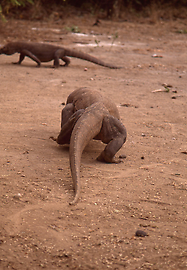The last dragon? The Komodo dragon ( Komodo varanus) is the last remnant of giant reptiles on Earth#
by

However, dragons are pure mythical creatures. In early modern times they were considered to exist in realitiy, although nobody had ever seen them. European (lat. Draco) and Chinese dragons (Ch. Long) have completely different characteristics. In Western legends dragons are swallowing their victims, both humans and animals after spitting fire and poisening them with their breath. The Chinese dragon is favourable to humans, ensures the right amount of rain and the distribution of water. The Chinese dragon is the symbol of the Chinese Emperor, the highest human being on earth.
Komodo dragons are completely different animals. Indigenous peoples of the Lesser Sunda Islands have always known them. They were scientifically described by zoologistis in 1912, only. The inhabitants of the islands of Komodo, Rinca, Gili Dasami, Gili Motang and Flores have been always hostile to this nowadays biggest lizard, because they minimized their precious grazing animals and huntable wildlife. Although they were hunted they were not exterminated because of their inedible meat and their skin, which is not usable. According to estimatimates there are still 3,000 to 4,000 lizards, 1,700 of them living on the island Komodo. They are named after this island. The red list of endangered species classifies them as „threatened“.
In 1980 Komodo Island was declared Indonesia's National Park. In the meantime, the island has been discovered by tourism which is detrimental for the biosphere of this rare reptile. In the old days it was common for visitors to buy a goat, which was used as prey to lure the animals from the forests. For a ong time now this has been forbidden in order to allow the dragons to remain in the native hunting behavior.
Male Komodo dragans have a length of up to 3 meters and a weight of up to 70 kilos. They are solitarie animals. Several of them you can see only when they are fighting for a dead prey or for territory. Femals lay around twenty soft-shelled eggs till hatching. They were also observed protecting their breed. Very often young lizards flee on trees because they are an easy prey for their enemies. Also, there is cannibalismus within the species. However, they soon overcome the critical age: the animals reach quickly adulthood in size and behavior.
The impressive animal is active during the day, hunts its prey from an ambush by lying in wait and grabbing the vicitm very quickly. The location of the prey is done by smell (using their tongue!) and is possbile over a distance of 5 km. Even 10 km were observed under favorable conditions. The forked tongue is a specially developed sensing organ. Young deer and small boars serve as main prey. It has been reported that the "dragons" even hunted and swallowed human beings. But this belongs most probably to the realm of legend. Attacks occur in exceptional situations and can be countred by using forked sticks.
The quick snapping of the prey causes deep bites. The opening of the body and the drawing out of the bowels leads to death within minutes. If the animal suceeds in breaking away and fleeing it will perish anyway. The komodo dragan has poison glands and pathogen bacterials in its teeth. It will take some time for the prey to die because of the injury by the poisenous bite. The drangons look for carcass in sucha case and feed on it.
They swallow the prey in one piece or in big hunks. In such a feast they can eat preys weighing 70% of their own body weight. Finding food is difficult and may be succesful only once in a month and must be enough for a long time. Komodo dragons can reach an age of 30 years. They have been also sucessfully bred in zoos.













